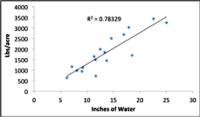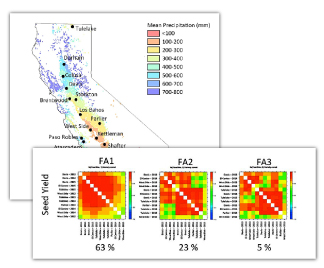Welcome to UC Oil Seeds Research & Information
Recently Published Papers

A Heightened Need for New Rotational Winter Crops in California

California has one of the most diverse and valuable agricultural industries in the world [1,2], but in recent years drought has drastically reduced the supply of irrigation in the state and climate change may lead to water supply constraints in the future [3-7]. An adaptation strategy to this scenario is the greater use of winter annual crops that can be grown at times of lower evapo-transpiration with less irrigation water, or on rainfall and stored soil moisture alone. Most annual cropping systems in California are dominated by warm-season species, however, and winter-crop options are limited to cereals and a few vegetable crops [1,8].
The introduction of new, economically viable, winter annual crops will therefore help farming industries remain viable in the face of climate variability and restricted irrigation water supplies.
Canola & Camelina Research Guide
Canola & Camelina as Potential Winter Cropping Alternatives in California
Canola (Brassica napus) is frequently used to diversify cereal-dominated cropping systems in other parts of the world [9-11], and could therefore be considered for the diversification of winter cropping in California. Globally, canola is one of the most important oilseeds in terms of total production [2]. Most canola production in the US takes place in ND, OK, MT, ID and MN [8], with effectively no commercial canola production in California. Relative to other oilseeds, canola has received the greatest research and development effort, and has the greatest yield potential under good growing conditions.

However, it can become unreliable in low rainfall conditions [14-16] and there are also other agro-ecological circumstances in the state where canola may not be compatible with existing rotations. We believe the oilseed species camelina (Camelina sativa), which is more cold tolerant and matures earlier than canola [17-19], could therefore be a good alternative for growers.
UC Davis Variety Trials and Agronomic Research on Canola & Camelina

The establishment of canola and camelina industries in California will require sustained research to identify locally adapted varieties, determine their yield potential, and understand agronomic practices critical to successful crop production. Our research group at the University of California, Davis, has been investigating canola and camelina since 2006. In 2012 our research group received funding from the UC ANR competitive grants program to conduct extensive variety trials and agronomic research on canola and camelina across California. In our progress report, we document our experiences and observations from this work. It is our intention that this report can act as a guide for other workers who wish to undertake field research relating to canola or camelina in California in the future. We hope that those conducting research relating to canola and camelina learn from our experiences with these crops in the state.
Successful extension and adoption of new crops requires consistent, reliable, rigorus and high quality R&D. Workers should aim to avoid unnecessarily tarnishing growers opinions regarding new through inappropriate variety choices or avoidable agronomic mistakes. This report is not intended as a Californian production guide for either canola or camelina. Production guides for both species are available from a number of other sources and we strongly suggest workers refer to these sources of information.
For detailed production information relating to canola, please refer to grower manuals provided by:
• Canola Council of Canada (http://www.canolacouncil.org/)
• US Canola Association (http://www.uscanola.com)
The Great Plains Canola Production Handbook is also useful source of information [17]. In some cases the information in these guides is for regions that differ climatically from California and therefore may not be directly applicable. Given the climatic similarities between California and the canola producing regions of southern Australia, we refer people to the Canola best practice management guide for south-eastern Australia [18] and Growing western canola: An overview of canola production in Western Australia [11]. There are fewer guides for camelina, but Washington State University recently published Camelina Production in the Dryland Pacific Northwest [19].
When conducting variety assessments we suggest workers adhere to established protocols for oilseeds. These include the Australian Grains Research & Development Corporation National Variety Trials (http://www.nvtonline.com.au) and the Kansas State University National Winter Canola Variety Trials.

